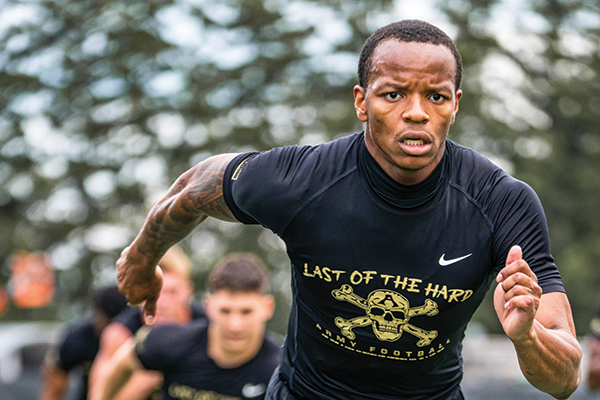By Thomas Veale ’93, Guest Writer
Athletics at West Point, as every graduate knows, are a massive endeavor. Currently, the field of athletics at West Point ranges from seven core curriculum physical education classes to 12 company athletic sports, 16 competitive club sports teams, and nearly 30 intercollegiate Division I or II teams. West Point athletes enjoy access to more than 500,000 square feet of fitness facilities, and they’re frequently reminded of the connections among fitness, leadership, and teamwork that directly translate to success in battle.
To enable these cadets to perform their best and achieve their goals, the Sports Performance Program, a division within Army West Point Athletics Department (AWPAD), integrates Strength and Conditioning, Athletic Training (with Sports Medicine), and Performance Psychology into a holistic and cohesive methodology.
Strength and Conditioning
Scott Swanson oversees the Sports Performance Program for all West Point’s cadet-athletes. As the Director of Strength and Condition (S&C) for AWPAD, he and his assistants focus on the strength, speed, conditioning, and nutritional support for all corps squad team members.
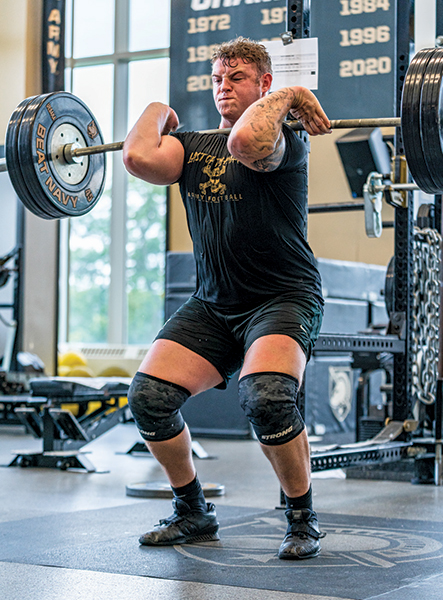
With a Master of Science in Education degree in health, sport management, and exercise science from the University of Kansas, Swanson came to West Point in 1995 as part of what was then a much smaller S&C staff. In the summer of 1997, he took a position at Stanford University assisting with the strength and conditioning of Stanford’s football team and supervising the strength and conditioning of its basketball, swim and dive, and hockey teams. During his tenure there, the Cardinal went to the Final Four in men’s basketball and won both men’s and women’s national championships in swimming and diving. With exceptional experience and achievements under his belt, Swanson returned to West Point in 1998 to oversee its entire S&C program.
In addition to leading the S&C and Sports Performance staffs, Swanson interacts with cadets during workouts, weightlifting, speed training, and team practices. He also maintains relationships and connections with his colleagues at other Division I sports programs. “We match up well with programs around the country,” he says. “We have a large, well-educated and energetic staff committed to maximizing the performance of all our cadet-athletes.”
Grateful for his time and experiences at Stanford as the university built its program, Swanson points to it as a model for strength and conditioning. He also points to the rapid evolution of technology in the S&C field: “The use of velocity-based systems to track how fast you move a bar, to heart rate and GPS tracking, and daily readiness and sleep tracking have all enabled athletes to improve their performance,” he says.
Remaining current in the field of Sports Performance requires consistent improvement. “We’re working to continually evolve our program with additional staff and resources, and we’re working to create the first Strength and Conditioning Endowment, funds that would benefit all the staff and cadetathletes by providing resources to further education and purchase state-of-the-art equipment,” Swanson says.
Like his peers, Swanson works with cadets during their entire 47-month experience at West Point, often forming relationships that extend beyond graduation. “After they graduate, many cadet-athletes continue to talk to me about their current training programs.” These graduates often continue and adapt their athletic training to help them achieve success in Ranger School, Special Operations selection, and other physically demanding military endeavors.
When asked to boil his criteria for success down to a single statement, Swanson keeps it simple: “Beating Navy! That makes us all successful,” he says.
Athletic Training
Some of the most powerful memories stirred up among athletes involve the training room: a place directly associated with preparation for, and recovery from, athletic competition.
Tim Kelly joined the athletic training staff as an assistant in 1987 and was named head athletic trainer in 1992. At the University of Iowa, he majored in athletic training and immediately started seeking jobs with the National Football League. “By the time I graduated from Iowa, I had 26 letters of rejection: one from every team that existed back then!” he laughs.
As luck would have it, Kelly was offered an internship with the Buffalo Bills his junior and senior years, and then for his two years in graduate school. After an additional postgraduate season with the Bills, he accepted an offer from West Point and has remained here ever since. “Two of the athletic trainers at Iowa had worked at West Point and often talked about their mentors here,” says Kelly. “The head athletic trainer of the Bills had also worked at West Point, so when the position opened up, he encouraged me to apply.”
“The Army Sports Performance Program is all about cross-communication among people working for a common goal. It’s about synergy. I’ve never been anywhere that creates teams as well as West Point does. We’re all pulling in the right direction and focusing on the cadet-athlete here.”
— Tim Kelly Associate Athletics Director-Head Athletic Trainer
Kelly’s 20-person staff of athletic trainers is responsible for the health and welfare of cadets on all athletic teams. This includes cadets with sports injuries as well as those experiencing temporary illness or other health challenges. “We interact with them daily,” says Kelly. “We evaluate, treat, and rehabilitate injured cadet-athletes as quickly and safely as possible; and, as Head Athletic Trainer, one of my primary responsibilities is to empower the staff by ensuring they have everything they need to do their jobs.” West Point’s athletic trainers engage in regular communication with more than 1,000 cadet athletes, as well as with the USMA faculty, staff, physicians, officials, and coaches who support them.
Kelly attended the National Athletic Trainers Association Conference in Indianapolis, Indiana in early summer. “West Point is unique in comparison to other Division I athletic programs, especially in the number of athletes we support,” he says. “At the University of Iowa, they might have around 400 athletes to support; here, we have almost 1,100.” The relationships built and maintained here endure after a staff member goes elsewhere. “I still maintain friendships with my colleagues who have departed for other colleges, or even for professional sports,” he says. “Sometimes, we share ideas on training and bounce ideas off each other regarding treatment or rehabilitation for a specific injury.”
When it comes to intercollegiate athletics, the differences between West Point and other institutions are significant. “My day is different than most of my colleagues at other places,” he says. “Given their time in classes, official duties, and military training, I have about two to three hours with cadet-athletes every day; but, at other places, athletic trainers have all-day access to their athletes.”
Management of West Point athletes and their time is a major challenge for athletic trainers. “Imagine having to tell a coach that his quarterback got a concussion in boxing class,” Kelly says. “Our athletic trainers, and the Army Sports Performance Program as a whole, provide a unified approach to minimizing risks and spreading out competing demands.” Kelly and his team try to identify challenges and then lay out potential solutions to address problems or risks that allow decision makers to make informed decisions. These decision makers include leaders at West Point’s highest levels.
One challenge is to maximize athletes’ preparation by managing academic loads and summer training assignments. “If we can give fall athletes some preparation time at the end of the summer, they’re better prepared from a strength, conditioning, and nutrition standpoint when fall sports begin.”
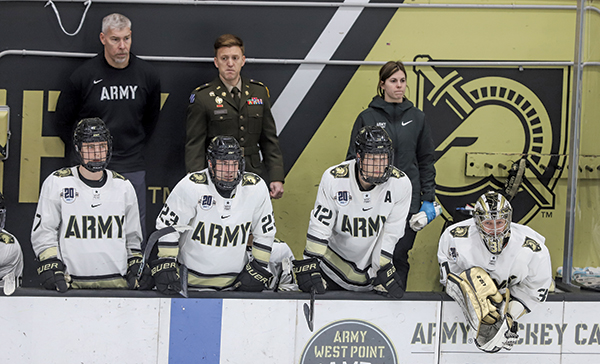
Another challenge is when spring sports championships extend into or beyond Term End Exams. “Baseball, for example, has gotten much more competitive in the last 10-12 years, and the administration has been very good about accommodating cadets’ ability to complete academic requirements while competing in championships or tournaments,” Kelly notes. In the past, there have been times when cadet-athletes have had to take examinations on a Saturday morning before a competition. “That has a big effect on morale and stress,” says Kelly, “and being flexible with cadet schedules has improved performance greatly.”
After more than 36 years in his position, Kelly has gained a lot of insight into what makes a cadet-athlete better. “The schedule is more complex and challenging now than it’s ever been,” he says. “Balancing needs and requirements is a challenge, and we find that cadets who can manage their time better tend to perform better.”
As a part of the Sports Performance Program, athletic trainers join their colleagues in addressing athletes’ strengths, challenges, and needs. Kelly says: “We meet regularly to discuss cases and remain aggressive in meeting the challenges. We work with coaches, physicians, the Center for Enhanced Performance, tactical officers, and staff and faculty to ensure we’re doing everything we can. When people work together instead of in separate silos, there’s always a better outcome for the cadet who’s injured or needs something. The Army Sports Performance Program is all about cross-communication among people working for a common goal. It’s about synergy. I’ve never been anywhere that creates teams as well as West Point does. We’re all pulling in the right direction and focusing on the cadet-athlete here.”
Kelly says that one of the greatest benefits to his job is the people he meets and maintains relationships with: “Our athletes are here for a different reason. They are here for a common goal: to graduate, commission, and serve the nation. I just had a member of the 1992 football team contact me and thank me for working on his foot so he could play in the Army-Navy Game. When I get these kinds of emails, or when players come back for a football reunion, they still talk to me about how their knees or shoulders are doing! Seeing the developmental process from R-Day to Graduation Day is the most rewarding thing at West Point. It’s also great to see former cadet-athletes come back as staff or faculty, and when I go to Eisenhower Hall, I can actually count the number of cadets I helped who ended up being generals. You don’t get that anywhere else.”
(Athletic Training con’t) Sports Medicine
The Director of Sports Medicine oversees all medical aspects of support for athletics, including staffing, training, communication with stakeholders, medical paperwork, and the administration of medical care itself.
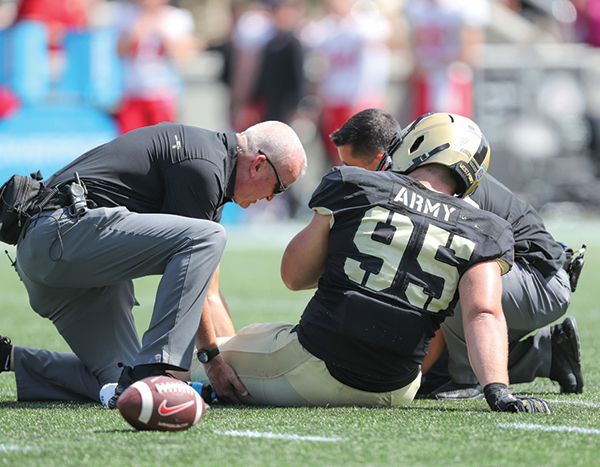
Rachel Leahy currently serves as Director of Sports Medicine and as the medical director for Army Summer Camp. Leahy has two years in her current role, and her four years at West Point have included support to Army West Point Volleyball, Softball, Rugby, and Hockey. Leahy got her bachelor’s degree at Quinnipiac College and her master’s degree and internship in health services administration at the University of Wyoming.
Leahy explains the daily duties for the Sports Medicine staff: “We treat athletes for injuries, handle rehabilitation, check on surgeries, schedule and take appointments, communicate
with doctors, and cover practices and conditioning sessions.” During competition, the Sports Medicine staff travel with teams, attend to team members on the bench, modify practices when necessary, provide after-practice treatment, and provide first aid and emergency care as required.
The importance of the Sports Medicine staff was highlighted on January 5 this year in Bridgeport, Connecticut, where the Army West Point Hockey Team was playing Sacred Heart University. After a collision, one player’s skate cut across another player’s neck, resulting in extensive, life-threatening bleeding. Before Emergency Medical Services reached the ice, Leahy had stopped the bleeding. Thanks to her quick action and a well-rehearsed process, the player went immediately into surgery and has recovered.
The life-saving steps taken by the Sports Medicine staff result from practices developed over time, including medical reconnaissance at game sites and detailed coordination with host facility officials. “We also scout out unique needs for our athletes, such as warm-up equipment, and we go over emergency procedures, contact lists, and available medical assets,” Leahy says. “When teams come to West Point to compete, my counterparts’ abilities might be complicated by access restrictions here,” she says, “but we help them understand the nuances, such as where the facilities and restricted areas are, what’s available to guests, and who can help.”
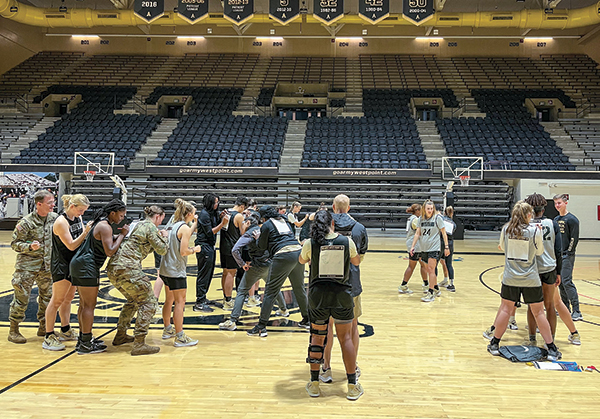
One of Leahy’s roles in the Sports Performance Program is to assist the director in filling and growing the Sports Performance staff, which includes seeking to fill the Sports Nutritionist role. The staff member who fills this role will watch cadets’ diets for height-weight, endurance, and performance factors. This individual will also oversee dietetic needs such as fueling for competitions and meet one-to-one with cadets who have specific needs or post-operative requirements.
When asked what the future looks like for West Point’s Sports Performance Program, Leahy points to the rising importance of technology. “There’s a lot of tech in our field, such as devices that track sleep, heart rate, high-intensity minutes, and heart-rate zones,” she says. Such technologies produce a lot of data, and the challenge is how to filter it into useful and beneficial information. “The Hockey Team uses Whoop Bands to track their sleep, and we’re seeing trends on sleep patterns and how we can adjust practice and travel schedules.”
Performance Psychology
During periods of high stress and anxiety, athletes can become their own worst enemies. Combating overthinking, nerves, and self-doubt enables cadets to perform at their highest levels, regardless of internal and external stress factors. Leading the effort in support of cadet-athletes’ mental game is Dr. Kathryn “Kat” Longshore, Director of the Performance Psychology Program in the Center for Enhanced Performance (CEP), a West Point academic research division (e.g. Dean) support center that includes both performance psychology and academic excellence programming for the entire Corps.
“I don’t know that any other program has the resources we have in terms of sports psychology. We are pretty unique, and that reflects the academy’s priority on supporting cadet performance.”
— Dr. Kathryn Longshore, Director, Performance Psychology Program, Center for Enhanced Performance
Cadets who were at West Point during or after 1991 fondly recall the Center for Enhanced Performance as the “Egg Chair People,” so called because of the white, oval, egg-shaped Alpha Chambers used then for mental performance enhancement. “The new Alpha Chambers are black,” she laughs, “But yes, we’re still familiar with that name.”
Joking aside, Longshore is quite serious about the impact of psychology on cadets’ performance. “Our goal is to enable cadets to perform their best when it matters the most,” she says. Longshore is no stranger to West Point’s fields of friendly strife. Prior to becoming the Director of Performance Psychology last February, she served as an instructor for nearly three years; she also recalls the first time she set foot on West Point as a softball player for Lafayette, a Patriot League rival.
“We think of performance holistically, both within academics and all the physical requirements here, such as courses in survival swimming and military movement, the Indoor Obstacle Course Test, Army Combat Fitness Test preparation, and the overall setting and achieving of goals,” she says.
When cadet-athletes find themselves in high-pressure situations, they can rely on mitigation skills gained from the Performance Psychology Program. “Things like Army-Navy competitions are high pressure,” she says. “Our goal is to keep our cadets focused on the bigger picture: Who is Army? Who do we want to be when the pressure is on? Those are the times we need to double down on our breathing exercises and other things we do to manage our performance. Once the whistle blows, it’s still just soccer or basketball. We help cadets remember who they are and why they are there.”
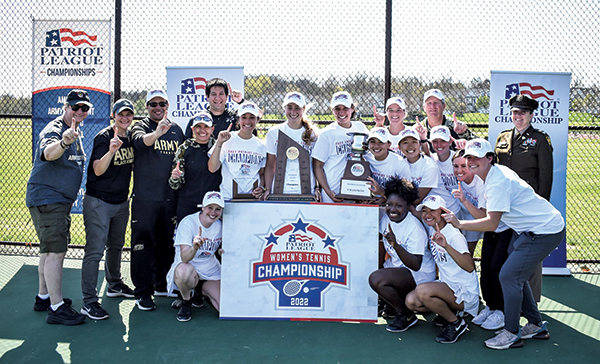
In her capacity, Longshore serves as the course director for PL360: The Psychology of Human Performance. Her team also supports a wide range of cadet activities, from field training to academics and to club, team, and individual sports. If a cadet has issues with Camp Buckner’s “Slide for Life,” she and her team provide interventions to manage the cadet’s physiological response. If a corps squad golfer has the “yips,” performance psychologists can take their work to the driving range. If an athlete or coach wants an individual or team session, Longshore and her team are there. “We focus on skill or teambuilding, go to games, provide a sounding board for coaches, and support anyone who wants or needs it,” she says.
A recent success Longshore recalls is her team’s assistance with the Army West Point Women’s Tennis Team in winning the 2022 Patriot League Championship. “Tennis is viewed as an individual sport, but in college competition, tennis wins or loses as a team,” she says. Army had lost to Navy and Boston University in back-to-back weekends prior to the Patriot League Championships.
When called in to assist, Longshore and her team helped the women stay focused on being adaptive in changing conditions and on encouraging one another despite the pressures on the individual. “Army went on to beat Navy in the semifinal, and we beat BU in the final: both victories came down to one of the last matches, and Army’s team of nine played and cheered each other as if there were 25-30 of them. The ladies’ success as a team came down to their buying into their individual roles and doing what the team needed. They came together as a unit and achieved well above what they thought they could do. In short, they won because they were the better team that day,” says Longshore.
When asked which areas of performance psychology she would like to see expanded, she pointed to ever-increasing virtual reality technology. “I would love to see more sports-oriented virtual reality offerings through the West Point Simulation Center. We are working with them to build out a library of scenarios and videos beyond existing footage for the dive platform and parts of the Indoor Obstacle Course Test. It’s high-cost, but high-payoff, and it puts Army on the cutting edge. We’re very excited about the possibilities.”
When asked how Army West Point’s Performance Psychology program compares to those of her Division I peers, Longshore responds, “I don’t know that any other program has the resources we have in terms of sports psychology. We are pretty unique, and that reflects the Academy’s priority on supporting cadet performance.”
Thomas F. Veale is a 1993 graduate who retired as a colonel with 26 years’ service in Infantry and public affairs. He served two tours on USMA faculty, including time as a football academic mentor and course director for EN101: Composition. He holds a Ph.D. in literature from the University of Kansas and currently resides in Rainier, WA.
Read the complete Fall 2023 edition of West Point magazine here.

